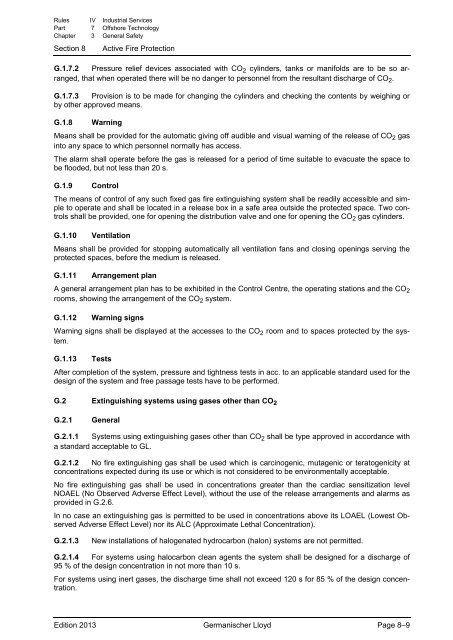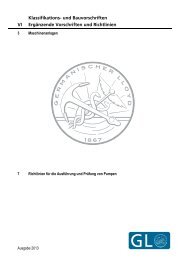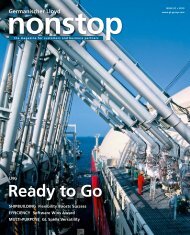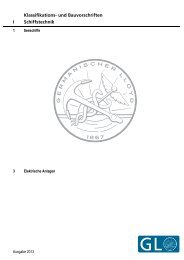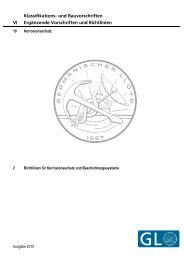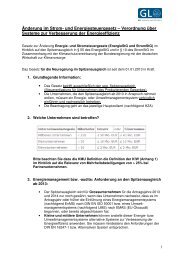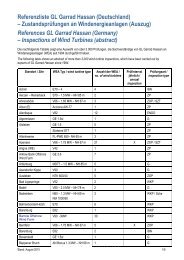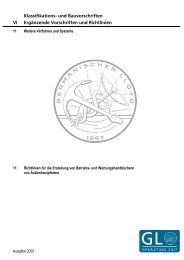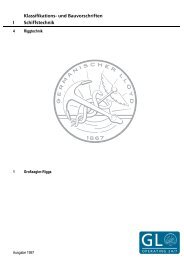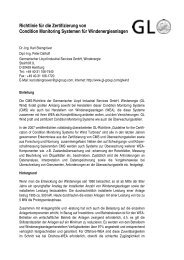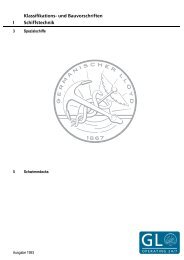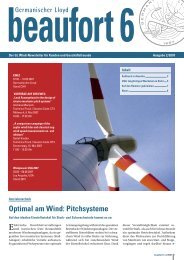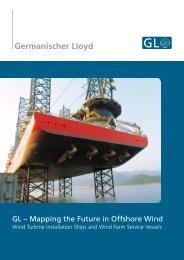(IV-7-3) General Safety
(IV-7-3) General Safety
(IV-7-3) General Safety
You also want an ePaper? Increase the reach of your titles
YUMPU automatically turns print PDFs into web optimized ePapers that Google loves.
Rules <strong>IV</strong> Industrial Services<br />
Part 7 Offshore Technology<br />
Chapter 3 <strong>General</strong> <strong>Safety</strong><br />
Section 8<br />
Active Fire Protection<br />
G.1.7.2 Pressure relief devices associated with CO 2 cylinders, tanks or manifolds are to be so arranged,<br />
that when operated there will be no danger to personnel from the resultant discharge of CO 2 .<br />
G.1.7.3 Provision is to be made for changing the cylinders and checking the contents by weighing or<br />
by other approved means.<br />
G.1.8 Warning<br />
Means shall be provided for the automatic giving off audible and visual warning of the release of CO 2 gas<br />
into any space to which personnel normally has access.<br />
The alarm shall operate before the gas is released for a period of time suitable to evacuate the space to<br />
be flooded, but not less than 20 s.<br />
G.1.9 Control<br />
The means of control of any such fixed gas fire extinguishing system shall be readily accessible and simple<br />
to operate and shall be located in a release box in a safe area outside the protected space. Two controls<br />
shall be provided, one for opening the distribution valve and one for opening the CO 2 gas cylinders.<br />
G.1.10 Ventilation<br />
Means shall be provided for stopping automatically all ventilation fans and closing openings serving the<br />
protected spaces, before the medium is released.<br />
G.1.11<br />
Arrangement plan<br />
A general arrangement plan has to be exhibited in the Control Centre, the operating stations and the CO 2<br />
rooms, showing the arrangement of the CO 2 system.<br />
G.1.12 Warning signs<br />
Warning signs shall be displayed at the accesses to the CO 2 room and to spaces protected by the system.<br />
G.1.13 Tests<br />
After completion of the system, pressure and tightness tests in acc. to an applicable standard used for the<br />
design of the system and free passage tests have to be performed.<br />
G.2 Extinguishing systems using gases other than CO 2<br />
G.2.1<br />
<strong>General</strong><br />
G.2.1.1 Systems using extinguishing gases other than CO 2 shall be type approved in accordance with<br />
a standard acceptable to GL.<br />
G.2.1.2 No fire extinguishing gas shall be used which is carcinogenic, mutagenic or teratogenicity at<br />
concentrations expected during its use or which is not considered to be environmentally acceptable.<br />
No fire extinguishing gas shall be used in concentrations greater than the cardiac sensitization level<br />
NOAEL (No Observed Adverse Effect Level), without the use of the release arrangements and alarms as<br />
provided in G.2.6.<br />
In no case an extinguishing gas is permitted to be used in concentrations above its LOAEL (Lowest Observed<br />
Adverse Effect Level) nor its ALC (Approximate Lethal Concentration).<br />
G.2.1.3<br />
New installations of halogenated hydrocarbon (halon) systems are not permitted.<br />
G.2.1.4 For systems using halocarbon clean agents the system shall be designed for a discharge of<br />
95 % of the design concentration in not more than 10 s.<br />
For systems using inert gases, the discharge time shall not exceed 120 s for 85 % of the design concentration.<br />
Edition 2013 Germanischer Lloyd Page 8–9


